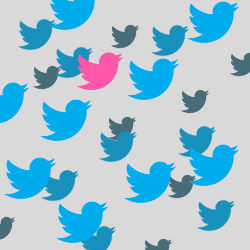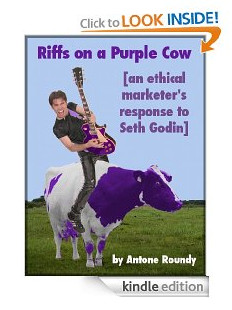When you purchase through links on our site, we may earn an affiliate commission (details)
The Secret to Using Auto-DMs on Twitter
by Antone Roundy | 2 Comments | Premium Content, Social Media/Networking

The verdict is in on auto-DMs -- those direct messages you receive shortly after following somebody on Twitter. The judge and jury agree: everybody hates 'em. Some people unfollow anyone who sends one. Don't use 'em.
But wait...breaking news! The decision has been overturned on appeal!
That is, if you know how to write an auto-DM with the right appeal, they can be a powerful tool for sparking engagement on Twitter. If you're skeptical, I don't blame you. I've only seen a handful of auto-DMs in my life that pass muster. Today, I'm going to tell you how to write yours.
Most auto-DMs fall into one of the following categories (none of which win on appeal):
The Polite Irritant
These are the ones that say "Thanks for following me! I look forward to getting to know you." Even if they're sincere, and even though they're the kind of thing you should say during a real-world interaction with a stranger, on Twitter, they're just annoying.
It's like when my kids yell at me from across the house that they need to tell me something. Then, when I stop what I'm doing and go ask them what it is, they say "I love you." That's it. Sure, I appreciate the thought. But the least they could have done was prove it by coming to me and saying it at my convenience instead of theirs.
Auto-DMs that don't deliver a benefit fail because they don't pay the recipient for their time and attention.
The Freebie
One of the most common types of DMs are those that attempt to deliver a benefit by saying, "Thanks for following me. Download my free eBook."
Sure, one person in two million will download and enjoy your free eBook. But it's still a UBT (Unsolicited Business Tweet). If you were to engage your new follower first, and verify through that engagement that they're the kind of person who'd benefit from your book, then it'd be fine to DM them and tell them where they can download it. Otherwise, your offer is spam -- at least that's how it feels to the recipient.
And by the way, don't fool yourself by thinking that everyone in the world would benefit from your book. Even if your book really is something anyone could use, it's like the sandwich you're eating for lunch. Everyone in the world would benefit from eating your lunch. But most of them already have their own lunch -- possibly even a better lunch -- so they don't need yours.
The Spam
Getting even worse, there are the DMs that say, "Thanks for following me. Check out this cool [product] I found."
No, thanks.
No matter how well-intentioned your auto-DM, no matter how great the resource is that you're linking to, no matter how sincerely you really, from your heart, do want to send that message to everyone in the entire world, nearly all auto-DMs suffer from one major handicap. They're auto-DMs, and people hate 'em.
They've already seen so many polite irritants, self-promoting freebies, and spams, that the moment they catch a whiff of that auto-DMs smell, they start to gag and click the "delete" button.
So, how do you craft an auto-DM that gets a response? Let me share a few keys:
- Don't say "thanks for following me." Why not? Because no matter how appealing the rest of your message is, those words will trigger the auto-DM gag reflex. You might as well start your message off by saying, "This is spam. Wanna bite?" I used to start one of my auto-DMs with "Thanks for the follow." When I replaced the opening, my response rate jumped.
- Don't talk about yourself, your product, a great resource you found, etc. The internet has billions of great, free resources. Until you've given people a reason to believe that you've found one that they really need, there's no point trying to tell them about yours.
- Ask a question. Make it a question that relates to your business, but don't make it about you. And make it one that someone in your target market will want to answer. This is a big key. When you ask a question, you're showing interest in them. Instead of saying, "read my message," you're saying "I want to read your message." It's the exact opposite of most auto-DMs. And it's even better than, "I'm looking forward to getting to know you" or "I'm looking forward to reading your tweets," which rings hollow because you're doing nothing to prove it. When you ask a question about your follower, now you're proving it.
Here's the auto-DM I'm currently sending from one of my Twitter accounts:
Quick question: If you have a blog, will you tell me its address so I can check it out? Thanks, Antone.
(Please don't just copy it -- craft one that fits your goals -- more on that in a minute. And please don't spread it around, because I don't want all the spammers to start copying it.)
That's the one that used to start off with "Thanks for the follow." See how much better it is starting with "quick question"? It doesn't advertise that it's an auto-DM. If the person doesn't specifically remember that they followed me recently, that could even be a DM from a long-time follower.
See how the question expresses interest in them? I'm not asking them to do anything (other than dash off a quick message). I want their answer so that I can do something that they want me to do -- check out their blog.
And in case you're wondering, I really do want to check out their blog. Why? Because if it's a decent blog, I want to invite them to join one of my Critical-Mass Blogging Teams and/or tweet a link to one of their posts. And when I do, I'll @mention them in my tweet to make sure it gets their attention. People love it when you link to them, and they both notice and love it when you @mention them.
This is my formula for engaging people on Twitter, without having to spend all day trying to get one or two people to respond to you. Instead, you automate the first step, and follow up manually only with the people who respond.
By the way, "Engage" is the first step of something I'll tell you more about in a future post -- my "4 'N's of Twitter". Yeah, it doesn't start with the letter "N", but the name will make more sense once you know what the other three are.
My end goal is to build mutually beneficial relationships. Since my main product is a blogging tool, I ask about my followers' blogs. That way, the relationship starts off with the right focus, so as I move through the other 3 'N's, I don't have to change the subject and hope they stay interested.
To see a video demonstrating the tool I use to implement my "4 'N's" strategy, and to get 30 days free access, visit I Know Networking.





October 22nd, 2012 at 4:29 pm
Speaking of annoying... I've been following you for years, but do you plan on doing more of those "I start out by writing something great, and then you'll have to pay to read the rest" kind of blog posts?
October 23rd, 2012 at 10:11 am
Britt,
Sorry if that annoys. But yes, it's something I do here from time to time. All of the posts in the "Premium Content" category [http://whitehatcrew.com/blog/category/premium/] are partially limited to Inner Circle members.
Most of the posts here will continue to be 100% freely accessible.